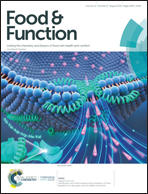Mulberry leaves ameliorate obesity through enhancing brown adipose tissue activity and modulating gut microbiota†
Abstract
The increased prevalence of obesity significantly affects human health worldwide. Improvement of glycometabolism by dietotherapy/herbal remedy is an effective approach to ameliorate obesity. In this study, high-fat-diet induced obese (DIO) mice were treated with mulberry leaves for 13 weeks. The results showed that mulberry leaves significantly alleviated adiposity of DIO mice including reducing body weight gain, fat accumulation and fasting blood glucose, and improving insulin sensitivity. In addition, mulberry leaves had protective effects on liver and kidneys. The abundant flavonoids, polyphenols and 1-deoxynojirimycin in mulberry leaves were likely responsible for their beneficial effects. Mechanistically, we found that mulberry leaves could alleviate obesity by enhancing brown adipose tissue (BAT) activity partly indicated by elevated thermogenesis and overexpression of uncoupling protein 1 in BAT. Moreover, mulberry leaves significantly increased the Bacteroidetes/Firmicutes ratio and Akkermansia level that were closely associated with obesity development and progression, and decreased the potential proinflammatory Proteobacteria in feces. These findings reveal that the mulberry leaf is an edible plant food with therapeutic potential for obesity and may provide dietotherapy/herbal remedy to the treatment of obesity and its complications.



 Please wait while we load your content...
Please wait while we load your content...